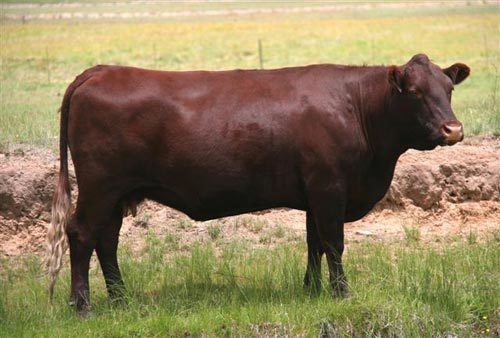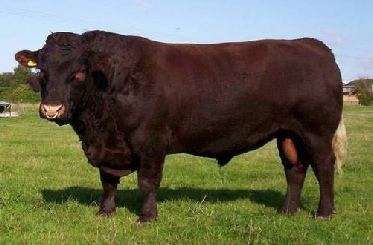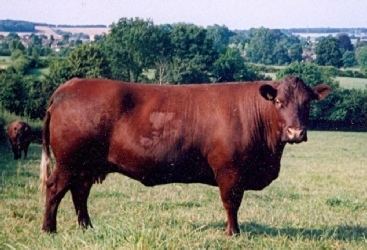Country of origin England | Use Beef, formerly draught | |
 | ||
Distribution World-wide, especially English-speaking countries Coat Rich red-brown coat, with a creamy white switch to the tail. Similar Gloucester cattle, Modern Langshan, Luing cattle, Devon Closewool, Chillingham cattle | ||
Sussex cattle are a red breed of beef cattle from the Weald of Sussex, Surrey and Kent in south eastern England. Descended from the draught oxen long used on the Weald they were selectively bred from the late 18th century to form a modern beef breed which is now used in many countries around the world. They have a thin summer coat and many sweat glands, but grow a thick coat in winter, so they are suited to both hot summers and cold winters. They have a placid temperament but can be very stubborn.
Contents

Description

The Sussex has a rich red-brown coat, with a creamy white switch to the tail. It is a medium-sized, long-bodied animal, and traditionally it has white horns, although naturally polled strains have also been developed.
History

The Sussex is one of several similarly coloured breeds of southern England – the others include the North Devon, the Hereford, the Lincoln Red and the Red Poll. All these breeds derive originally from the traditional multi-purpose red landrace cattle of the region. Ox ploughing continued longer in the Weald and on the South Downs than in most parts of England, and so the Sussex remained until relatively recently as heavy boned, large shouldered, draught animals.

Arthur Young Junior wrote in the early 19th century that the cattle of the Weald "must be unquestionably ranked among the best of the kingdom." William Cobbett in his Rural Rides also expressed surprise at finding some of the finest cattle on some of the most impoverished subsistence farms on the High Weald. The breed was numerous in Kent and the Wealden parts of Surrey as well as in Sussex in the late 18th century when Arthur Young toured Sussex and praised the breed in his book Agriculture of Sussex of 1793. He stayed at Petworth House where the progressive 3rd Earl of Egremont established a Sussex herd in Petworth Park which is still there today. High corn prices during the Napoleonic Wars led to a lot of grassland on the Low Weald being ploughed up and cattle herds greatly declined. Later in the 19th century rail transport caused an increase in dairy farming to supply the London market with a consequent decline in beef cattle breeding. A herd book was established in 1874.
Great Britain
The stronghold of Sussex cattle in Britain remains the Wealden counties of Sussex, Kent and Surrey, but they are not particularly common even there, and are rare elsewhere in Great Britain.
Australia
The breed is used in Australia, where it arrived in the early 1970s. A polled strain has been selected.
Canada
Sussex cattle have been found to do well in Alberta.
New Zealand
Introduced into New Zealand in 1970 they are classed as a rare breed with only three breeders listed.
South Africa
The breed was introduced to South Africa in the early twentieth century and is popular in the North West Province where the breed society has its headquarters in Klerksdorp.
United States
John Overton Lea imported Sussex cattle to Tennessee in 1884 and had one hundred head in 1888
